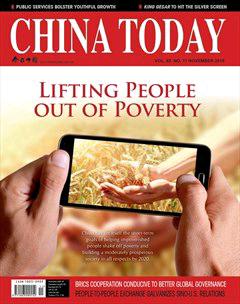China’s Poverty Relief Efforts
China’s Poverty Relief Efforts
China was the frst developing country to meet the UN Millennium Development Goals (MDGs) target of halving the proportion of the population living in poverty, well ahead of the 2015 deadline. The number of people living in extreme poverty in China fell from 836 million in 1987 to 156 million in 2010. According to World Bank statistics, almost 700 million have been lifted out of poverty. China’s official data show that by 2015, poor people in rural areas fell to 55.75 million. The country aims to eradicate poverty by 2020, when it achieves its goal of a moderately prosperous society.
China’s remarkable poverty reduction achievements owe much to its extraordinarily rapid economic development since reform and opening-up came into effect. In the three decades from 1978 to 2007, China’s GDP showed an average annual growth of 10 percent, and the per capita annual income of rural residents rose from RMB 134 to RMB 4,140. The proportion of rural residents living in absolute poverty was thus reduced from 30.7 percent to 1.6 percent of the total rural population.
Over that period of time, the people’s communes were replaced by the household contract responsibility system. Its implementation sparked farmers’ enthusiasm for production and expanded effective land use. The market gradually came to determine prices of agricultural products, and various township and village enterprises proliferated, creating new jobs and higher incomes. More than 200 million rural residents also went to work in cities where they could earn higher salaries.
As the country opened wider to the outside world, the export of labor-intensive goods soared. Overseas companies and foreign investment were permitted in the Chinese market, which created even more job opportunities for migrant workers.
Meanwhile, the Chinese government invested in improved infrastructure in poverty-stricken areas, and developed projects to spur local economic development. It also established a twinning arrangement whereby rich coastal areas offer aid and advice to their less developed inland counterparts to help them get rid of poverty. Civil society as a whole has also been encouraged to participate in poverty alleviation.
Today, China’s pace of economic growth is slower. The country now seeks a sustainable development model that coordinates economic growth with resources and the environment. In areas suffering from both poverty and resource shortages, the government supports development of green industries and ecofriendly businesses, such as livestock-breeding and tourism, which creates local employment. The government also periodically evaluates whether or not these efforts are achieving progress towards the desired goals of economic development, environmental protection and poverty reduction.
In the past, China had concentrated and contiguous areas of poverty-stricken people. The situation has now changed. Reasons for poverty are more complex, and the poor are scattered over different areas. The Chinese government has rolled out more targeted and precise measures to help people of differing circumstances and needs. These include arranging training courses for farmers, either to help them fnd work or improve their farming effciency. Poverty relief departments also gather feedback from the poor to determine their needs, so enabling the government to help them through targeted measures.
The Chinese government gives consideration to healthcare, education, and resources when setting new standards for setting the poverty line, in an endeavor to prevent any recurrence of poverty.
China’s work and achievements represent its global contribution to narrowing the rich-poor gap and building the world into a harmonious and happy “global village.”

